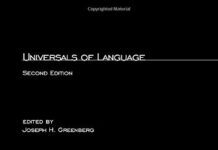
Ebook Info
- Published: 1987
- Number of pages: 571 pages
- Format: PDF
- File Size: 14.96 MB
- Authors: Joseph H. Greenberg
Description
This book is concerned primarily with the evidence for the validity of a genetic unit, Amerind, embracing the vast majority of New World languages. The only languages excluded are those belonging to the Na-Dene and Eskimo- Aleut families. It examines the now widely held view that Haida, the most distant language genetically, is not to be included in Na-Dene. It confined itself to Sapir’s data, although the evidence could have been buttressed considerably by the use of more recent materials. What survives is a body of evidence superior to that which could be adduced under similar restrictions for the affinity of Albanian, Celtic, and Armenian, all three universally recognized as valid members of the Indo-European family of languages. A considerable number of historical hypotheses emerge from the present and the forthcoming volumes. Of these, the most fundamental bears on the question of the peopling of the Americas. If the results presented in this volume and in the companion volume on Eurasiatic are valid, the classification of the world’s languages based on genetic criteria undergoes considerable simplification.
User’s Reviews
Reviews from Amazon users which were colected at the time this book was published on the website:
⭐This book poses a mighty challenge to the orthodox view that there are up to 200 or at least several dozen independent families of indigenous languages in the Americas, by asserting that there are no more than three: Eskimo-Aleut which is related to the Eurasian macrofamily extending across Europe and Northern Asia; Na-Dene which is concentrated in the south- and northwest of North America, and Amerind, comprising about 90% of American languages.In seeking to reconstruct the evolution of language groups and the relationships among their component languages, linguists have become accustomed to comparing a few languages across many words, but Professor Greenberg’s approach is the opposite – he looks at a large number of languages across a smaller number of words. The nature of the words is the important factor: the core lexicon which in the main consists of personal pronouns, numerals, body parts and terms for water, blood, moon, sun, night, day and the humble louse.Chapter One deals with the principles of genetic linguistic classification including Greenberg’s methodology used for his now universally accepted
⭐, synchronic & diachronic resemblance, sound correspondences & sound changes, multilateral comparison, recoverable vocabulary and petrified grammatical markers. The following chapter examines the unity and bounds of Amerind by providing some of the most striking pieces of evidence like pronominal prefixes indicating the possessor of a noun, ergative markers and first person plural inclusive versus exclusive.Greenberg examines a vast amount of lexical material, mostly Amerind. Chapter Three treats each of the 11 proposed subgroups of Amerind in a separate section with an enumeration of its languages and their classification, plus a brief history of previous taxonomic hypotheses and a set of characteristic etymologies. The following two chapters present the evidence for Amerind as a single macrofamily, with Chapter 4 providing about 1900 lexical etymologies common to two or more subgroups and Chapter 5 pointing out more than 100 grammatical features found across the subgroups.The penultimate chapter discusses the problem of Na-Dene whilst the final one deals with
⭐, Na-Dene’s connection to Dene-Sino-Caucasian and the historical implications for the settling of the Americas by three waves of peoples. This theory receives support from serological and dental evidence. Finally, Table 11 provides a hypothetical list of 14 global language families. Should Niger-Kordofanian & Nilo-Saharan of Africa, Indo-Pacific & Australian of Australasia and the three families North Caucasian, Sino-Tibetan & Na-Dene respectively have a deeper single origin, the number may be reduced to ten.The book contains 4 appendices (on glottochronolgy, mathematical bases of subgrouping, distribution of Amerind etymologies & summary of the classification), 3 maps, a bibliography and 3 indices: Amerind Etymologies, Language Names and General. Further interesting studies on historical linguistics and long-range comparison include Merritt Ruhlen’s
⭐, Dene-Sino-Caucasian Languages edited by Vitaly Shevoroshkin,
⭐by Allan R Bomhard and
⭐edited by Sydney M Lamb.
⭐Don’t buy this book for language classification. The proposal contained therein is undemonstrated and controversial. This is the near unanimous consensus of all Americanist specialists. See Bill Poser’s review below and Lyle Campbell’s (1997) extensive chapter on unreliable methodologies (such as the one used by Greenberg). The positive reviews below are by readers who probably not familiar with American linguistics. In order to get a better picture of the languages on these continents, readers will need to consult more than Greenberg.Look instead at:(1) the language volume (1996) of the “Handbook of North American Indians” published by the Smithsonian Institution(2) Mithun (1999) “The languages of native North America”(3) Campbell (1997) “American Indian Languages: The Historical Linguistics of Native America”(4) Campbell & Mithun (1979) “Languages of Native America: Historical and Comparative Assessment”(5) Terrence Kaufman’s (1994) chapter “The native languages of South America” in “Atlas of the world’s languages” (editors: C. Mosley & R. E. Asher)(6) Adelaar & Muysken (2004) “The Languages of the Andes”(7) Dixon & Aikhenvald (1999) “The Amazonian Languages”However, this book is good for thinking about new proposals. Many are worth being tested, particularly in South America. But, keep in mind there are several other proposals by others (including linguists before Greenberg, like Morris Swadesh and Jorge Suarez) that are worth considering.So, in short, take a look if you are curious about this book’s reputation, but keep in mind that it is unsupported by the linguistics community as a whole. However, in spite of the failure of this book’s contribution to historical linguistics, Greenberg is an excellent typologist who is widely respected for his contributions in this area of linguistics.
⭐The approximately 1,000 native languages of the Americas are classified into approximately 200 different language families by mainstream scholars, a very high level of diversity in comparison with, e.g., Europe, which contains only three language families (Indo-European, Finno-Ugric, and Basque). In this book, Greenberg claims to demonstrate that there are only three language families in the Americas: Eskimo-Aleut, Na-Dene, and Amerind. Eskimo-Aleut is uncontroversial, as is Na-Dene but for Greenberg’s inclusion of Haida, for which the evidence is generally considered unconvincing. The argument that most of the languages fall into an “Amerind” family is the main point of the book.Greenberg’s claim has been rejected by the great majority of specialists for two reasons. First, the method used, superficial lexical comparison, is known to be unreliable. The similarities presented may well be due to chance; even if they are not, the method cannot exclude borrowing as the source of similarties. Second, Greenberg’s data have been shown, in a number of published studies (including one by this reviewer), to be riddled with errors. An additional problem is that, although Greenberg offers a subclassification of Amerind, he presents no evidence whatever in support of it.In sum, this book does not provide either reliable information on the classification of the languages of the Americas or an example of valid historical linguistic methodology.
⭐Der Autor war bekanntlich einer der einflussreichsten “Stammbaumforscher” der Weltsprachen, dessen Kategorisierungen der eurasiatischen und afrikanischen Sprachen heute noch die Grundlage jeder diesbezüglichen Diskussion sind. Sein wichtigstes Kriterium zur Definition von Sprachverwandtschaften waren die unterschiedlichen Konsonanten zum Kennzeichnung der pronominalen Kategorien “ich/wir, du/ihr, er-sie-es/sie”. In diesem Werk hat Greenberg, auf Vorarbeiten von Edward Sapir (dem er das Werk widmete) und anderer aufbauend, für die amerindischen Sprachen (also unter Ausschluss der jüngeren Na-Dene und Eskimo-Aleutisch) zu den derart definierten 11 amerindischen Unterfamilien (Macro-Ge, Macro-Panoan, Macro-Carib, Equatorial, Macro-Tucanoan, Andean, Chibchjan-Paezan, Central Amerind, Hokan, Penutian, Almosan-Kerosiouan) Wortwurzeln zusammentragen, die die engere Verwandtschaft der Einzelsprachen jener Teilfamilien belegen sollen. Sein von ihm “hervorragender Schüler” genannte Merritt Ruhlen hat im Werk “On the Origin of Languages” die über 2.000 amerindischen Wortwurzeln Greenbergs in der alphabetischen Reihenfolge ihrer englischen Bedeutung aufgelistet, wodurch für sehr viele davon eine Wiederholung in mehreren Teilfamilien zutage getreten ist. Obwohl Greenberg sehr nahe dran war, hat er es kaum gewagt, Brücken zu eurasiatischen, geschweige denn afrikanischen Wortwurzeln zu schlagen. Zu stark war noch der Einfluss der “fundamentalistischen Indogermanisten”, die zuweilen sogar Vokalnuancen zum Ausscheidungskriterium machen.
⭐
Keywords
Free Download Language in the Americas 1st Edition in PDF format
Language in the Americas 1st Edition PDF Free Download
Download Language in the Americas 1st Edition 1987 PDF Free
Language in the Americas 1st Edition 1987 PDF Free Download
Download Language in the Americas 1st Edition PDF
Free Download Ebook Language in the Americas 1st Edition

